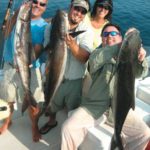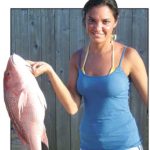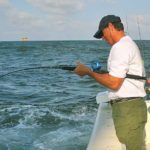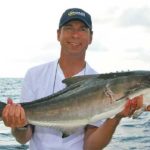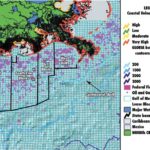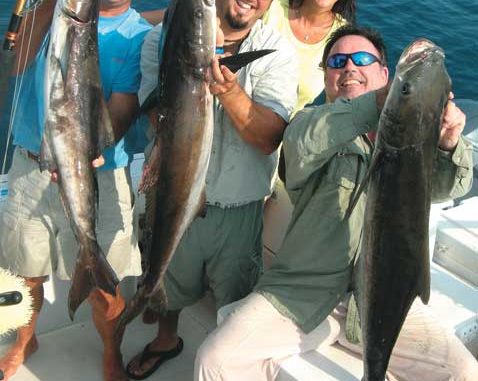
The West Delta, Grand Isle and South Timbalier blocks hold unbeatable cobia action this month.
Put some whiskers on a cobia, and there’s no doubt it would be more like a cat than a catfish. I mean, toss a string without a hunk of stink-bait on it in front of a catfish, and watch what happens. It would probably be as exciting as watching grass grow during a drought.Toss that same string in front of a cobia, and watch what happens. He’ll swim around it a while. Maybe pounce on it and swat it around with his nose. Then, out of the blue, he’ll act like he’s not even interested in it.
His phony disinterest can’t last forever, though, and sooner or later he’ll pounce again. If you’re lucky enough to have a hook tied to the end of that string? Well, curiosity not only kills cats; it also kills cobia.
And like cats, cobia have a knack for showing up in places where you least expect them. That’s why actually going out and trying to specifically target them is more an exercise in gambling than it is fishing a specific rig.
“What I like to say about cobia are that they are where they are,” said Capt. Jamie “The Cudaman” Gaspard with Pure Adrenalin Charters. “You don’t find them in the same spots over and over. They’re almost like a pelagic. They roam around a lot. We tend to use them as backup fish for our customers for that reason, but if some customers want lemon fish (a local name for cobia), then we’ll target them.”
Capt. Steve Tomeny has a similar opinion about where anglers can find cobia.
“We tend to catch them wherever we’re fishing,” he says. “There are some general areas where we catch them, but they do get spread out. Certain rigs or areas get hot, then a week later the cobia bite trends to a different spot. It probably has a lot to do with the current, water temperature or even whatever kind of bait they’re eating.”
Although both captains were a little vague in pointing out areas where offshore anglers could go catch cobia, it wasn’t because they were trying to keep them cloaked in secrecy. Rather, it was that neither wanted to pinpoint an exact spot that might be hot one week and dead the next.
However, when pressed on areas where they have had their best action in the past, both anglers pointed out a few spots that seem to hold cobia throughout the summer even though they might move around a lot within those spots.
“I do a lot of my lemon fishing out of the shallow West Delta rigs,” Gaspard said. “Those rigs are kind of on a shoal where it drops off. I like to fish the rigs in 60 to 100 feet of water. Plus, West Delta has a good amount of rigs, which is important, in my opinion, when looking for lemon fish.”
Gaspard likes tightly concentrated groups of rigs because he believes one of the keys to finding and catching cobia is to cover a lot of water.
“The more water you cover,” he said, “the more cobia you’ll catch. And West Delta gives you a bunch of stuff to fish because they’re all pretty close — within sight of each other.”
For that same reason, Gaspard also likes to fish the Grand Isle 40s. This block of rigs south of the popular fishing destination is similar to the shallow West Delta rigs in that there are a lot of attractive rigs to fish all within sight of each other.
“Pointing out which rig to fish within those areas — I would just be feeding you a bunch of crap,” Gaspard said. “I’ve caught them at buoys, big platforms and at the single-leg rigs. My thing is to get in those areas and cover water. And covering water at West Delta and the Grand Isle 40s gives you a better chance because there is so much stuff stacked together.”
Heading south out of Port Fourchon, Tomeny likes to hit some of the South Timbalier structures straight out of the pass. He pointed out the 151 and 130 blocks and even the 86 blocks farther north.
“All of those hold lemon fish all summer long,” he said. “A lot of times, we have our best cobia fishing at the single-post rigs and satellites within those areas. I think it’s got a lot to do with having better access to the fish at those kinds of rigs. We can get our baits to the fish easier on those than we can some of the big ones.
“On those big rigs, you could fish for an hour before finally catching one. You don’t see them as good on the bigger stuff or they don’t find you as easy. But on the small stuff? You’re the only game in town.”
However, one trend that Tomeny has noticed over the years is that the cobia below Fourchon move from deep to shallow later in the summer. The general belief is that the westerly cobia migration that sends them through the Florida, Alabama and Mississippi surf eventually puts them at a point at the mouth of the Mississippi River where they no longer follow the beach.
“Rather than head northwest up the beaches on the west side of the river,” Tomeny continued, “they work their way west a little bit before fanning out into the shallower stuff. That means they show up on the deep rigs earlier in the summer — 35 and 40 miles off as opposed to 5 and 10 miles off like you’ll find them in August.”
During August, Tomeny has frequently found cobia in 30 feet of water right off the pass below Port Fourchon. And he points out that many of the structures “right off the beach” can hold some cobia during the late summer.
Both captains say the majority of the cobia they catch come from sight casting to the fish as they swim around right under the surface. Gaspard likes to bring them up with chum, then put a bait within 5 feet of their noses.
“There might be one or two, or there might be eight or 10,” said Gaspard. “You just never know. When they do come up, you can pick around on them a while and catch a couple, but they’ll get wise to you pretty soon and leave. I like to have a big croaker or cigar minnow rigged up on a freeline, so I can pitch it to them when they come up.”
Although some anglers may claim they have a bait that cobia will never pass up, Gaspard says they are full of it. He has “tried all the freaking baits I’ve ever freaking heard of from a live croaker to a pogy to a jig — you name it,” and he’s had them turn them all down.
“The only thing that they won’t turn down is if he’s within 6 feet of my boat and I can get my gaff behind him,” Gaspard said. “I’ve probably free-gaffed 25 this summer. In fact, that’s the first thing I grab when they do come up. A lot of times they won’t bite anything, and if he comes within 6 feet of my boat he’s a caught SOB.”
Tomeny has a little bit different plan for cobia that won’t bite anything else. On those days when they just seem to bump his bait with their noses, Tomeny goes through four or five different baits because he believes one of them will eventually do the trick.
“If they don’t hit any of that stuff?” Tomeny went on. “I might grab some bologna from a sandwich and put it on a hook. And some people even swear by Vienna Sausages. I guess those cobia sometimes get tired of eating fish all day long, and they don’t want to pass up the chance to get a little pork sausage in them. Sometimes you can slip them a little something funny like that, and they’ll bite it.”
In the end, both anglers believe the key to consistently catching cobia is to have a single-hook rig ready to go for when cobia make their appearance at the surface. Whether they are chummed up or they follow other fish, more of them are caught right at the boat than any other way, and there’s no way to predict when they will come up.
“You’ve just got to be ready,” Tomeny said. “Sometimes you’ll get a big pod, and sometimes it will be only one or two. It doesn’t matter. Cast to them when they come up, and you’ll put your cobia in the boat.”
And there’s no better place to put cobia in the boat than below Port Fourchon. Cobia are where they are, and they are at West Delta, Grand Isle 40 and the South Tim blocks through the rest of this summer. Got your string ready? U
For more information, contact Capt. Steve Tomeny at 800-259-8452 and Capt. Jamie Gaspard at 225-572-5788.
